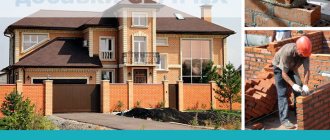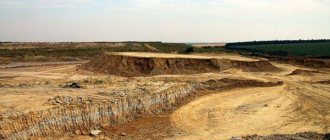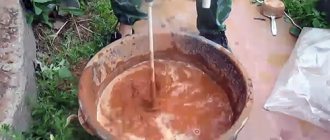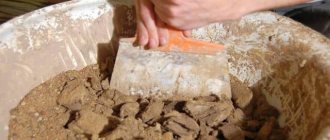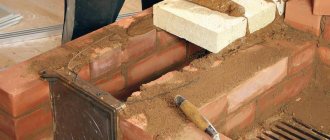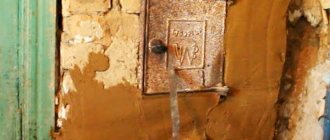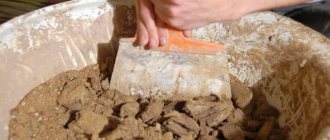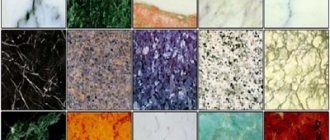Classification of furnace solutions
Firstly, we must immediately make a reservation that the construction of a furnace requires three types of masonry mortar. And that's the minimum. However, these solutions cannot be mixed like ordinary cement-sand ones.
The thing is that the stove consists of three structural elements: the foundation, the stove itself with a firebox, and the chimney. Now imagine that the foundation must withstand quite serious mechanical loads. And most often in winter its temperature is 0°. In the firebox the temperature reaches up to +1000C, and the chimney located outside is constantly exposed to low temperatures. Now it is clear that ordinary cement mortar will not withstand such varied loads.
Secondly, today the building materials market offers ready-made mixtures. It would seem very convenient. Add water according to instructions and apply. But let's look at the economic side of the issue.
Ready-made oven mixtures Source applesakhalin.ru
Laying one hundred bricks will require three buckets of mortar. And 100 standard brick blocks are not enough for half the cooking surface of a regular summer kitchen. Not to mention the foundation and chimney. That is, you will have to purchase a fairly large number of bags of dry mixture for ovens from the store. And the prices for this material are considerable. So think about how to prepare a solution for laying a clay stove without buying ready-made mixtures. It will cost many times less.
Understanding the terms
In the kiln business, three terms are used in relation to masonry mortars:
- Heat-resistant solution. This material can easily withstand heating to fairly high temperatures. And when cooled, it does not crack, does not deform, does not change its structure, and maintains a high design load-bearing capacity.
- Heat resistant. Such a solution can easily withstand dynamic loads in a heated state. It retains its mechanical characteristics during temperature changes. But the magnitude of thermal deformations is slightly lower than that of the heat-resistant version.
- Refractory. It absorbed all the characteristics of the two previous types. But at the same time, it easily tolerates the negative effects of chemically aggressive substances. This refers to waste carbon monoxide that passes through the firebox and chimney.
Now the question is what kind of mortar is needed for laying the stove. The answer is heat-resistant and fire-resistant.
Heat-resistant oven mixture for masonry Source catalogue.brick-concrete-concrete.rf
But as for the foundation, such a complex solution is not needed here. The thing is that this part of the structure is practically not subject to serious temperature fluctuations. After all, the foundation itself is a concrete monolithic structure on which two rows of bricks are laid. This is exactly what we are talking about. For their laying, ordinary cement-lime mortar is suitable. The main thing is to use red solid brick for masonry.
Now about the body of the furnace, or as it is called, the heat-storing part. In essence, this is a stove made of red solid brick of the M150 brand, inside of which there is a firebox. The latter folds separately, and more about it below.
So, in the heat-accumulating part of the structure, the heating of the bricks is small - up to +600C. But it is here that the bricks are exposed to intense exposure to carbon monoxide and acidic condensate. For masonry it is better to use ordinary clay mortar. Let’s immediately say that this mixture is simple in composition, the preparation method is specific. More about him below.
Next is the firebox, which is assembled from fireclay bricks. Here the temperature reaches +1200C, so a fire-resistant mortar is used for masonry - clay-clamotte.
Chimney mortar - lime Source i1.ytimg.com
Now the chimney consists of several parts:
- Source. Here the temperature does not rise above +400C, so the brick and mortar are exactly the same as in the heat-storing part of the furnace.
- Fluffing is a transition through the ceiling of a house. Temperatures in this part are low, but a certain structural strength is required. Therefore, for masonry we choose solid bricks and lime mortar.
- Chimney located in the attic and above the roof. High temperatures have no effect here. But there are special requirements for strength, especially for the external part. Because it is affected by wind loads. For construction you will need ordinary red brick and lime mortar.
- Pipe fluffing . Everything here is the same as in the previous paragraph.
Please note that each part uses its own brick and mortar. This is what allows you to save a lot on the purchase of building materials.
No. 4. Clay-fireclay mortar
It is recommended to use clay-chamotte mortar for laying the firebox allow the use of ordinary clay mortar when building stoves with a not very intense thermal regime: these are Dutch and Russian stoves, hobs, and barbecues.
In other cases, you will need gray, white or yellowish clay with high fat content. It is thinned with fireclay sand, but more often, to save money, a mixture of quartz and fireclay sand is used in a 1:1 ratio. Soft water must be used, with a hardness of up to 160 mg/l. The preparation is no different from ordinary clay mortar with one caveat - strength tests are not needed, because it is provided by the original raw materials.
A few words about fireclay
The question of what kind of solution the stoves are placed on involves one material that many consider to be a mineral. This is fireclay. We must immediately make a reservation that this is a mixture of high-alumina clay and several minerals: garnet, zirconium and others.
Fireclay is produced by deep firing of the prepared mixture. In this case, they burn even after complete removal of water from the mixture. The main task of the technology is to pelletize and sinter the components.
It is this material that is used in the process of making fireclay bricks, where the first one performs the functions of sand. For household stoves, bricks with a water absorption of 15-20% are suitable. As for solutions, here you can use fireclay in the form of a mortar - this is an unshaped mass. Or in the form of broken fireclay bricks, which are sold on the market as sand or crushed stone. Mortar is better.
Mortar is an unshaped mass of fireclay Source i.stroy-ka.ru
See also: Catalog of projects of houses with a stove for permanent residence
The right job with the right solution
The characteristics of plaster are important for the quality of the coating, but without following the application technique, even an expensive solution will certainly crack during use. Therefore, if you do the work yourself, strictly follow the algorithm of actions.
Preparatory stage
After completion of the masonry, the stove should stand for at least a month until the end of the initial shrinkage.
Join the joints, deepening them by 5-10 mm to increase the area of contact with the solution.
Clean the wall from dust and dirt using a brush and heat the oven to 50-60⁰C.
Moisten the masonry thoroughly with water so that the brick does not absorb moisture from the plaster, speeding up its drying.
Reinforcement of the finishing layer
photo from the site https://obustroeno.com
It is necessary to reinforce the surface, and there are several options for performing this stage:
Metal soft mesh. The metal must be galvanized so that the contours of the mesh do not show rust stripes. You need to take care of attaching the mesh at the stage of masonry, leaving wire outlets for it. If this has not been done, then the mesh will have to be secured with screws or nails into the seams.
Burlap or gauze. Opponents of this method of reinforcement point to the flammability of burlap, while supporters talk about environmental friendliness and the impossibility of ignition in clay. Having decided to reinforce the plaster with burlap, it is cut into squares, dipped in a liquid solution and glued to the wall after spraying.
Plastering
photo from the site https://kursremonta.ru
The plastering stage will require work to be performed in the following sequence:
Padding. You need to use deep penetration primers and prime the surface before applying each layer.
Spray. To spray, use a brush and the same solution as for plaster, only diluted with water to the consistency of liquid kefir. This is done to fill small irregularities and roughness, so as not to leave air voids that will lead to cracks.
Plaster. The solution is applied using a trowel and smoothed with a trowel, the thickness of each layer is 2-3 mm, while it is advisable to keep the total thickness of the plaster within 10-15 mm.
Covering. It is also done with a liquid solution, after which it is rubbed with a trowel. In the case of clay mixtures, grouting can be done with a rag soaked in the solution.
The stove cannot be lit for the next three days, and the first heating should not exceed half the maximum power of the stove.
If the finished plaster does crack, the crack must be repaired. To do this, it is expanded with a spatula, the surface is wetted and filled with the same composition that was used during the main work. Don't forget about primer and grout.
Now you know exactly how to make a mortar for plastering a stove, and let it please you with its impeccable appearance and cozy warmth for many years to come.
Properties of masonry mortars for furnaces
Before making a mortar for laying a stove, you need to understand that the properties and characteristics of the mixtures mentioned above determine their place of purpose in the stove structure. Therefore, more specifically about them:
- Clay. This is a cheap material that can cost you nothing if you find the right clay. But kneading it is a labor-intensive process. Here are the characteristics of the solution: strength and heat resistance are average - up to +1100C, fire resistance - absolute, maximum gas density. Can be used if the stove is built indoors.
- Lime. To prepare, you need to know one important nuance - you use lime that is slaked completely to the last grain. If this is not done, then there is a high probability that these grains will create conditions for the appearance of cracks in the masonry. And this reduces the quality of the seam. As for the characteristics, then: fire resistance and heat resistance are below average, strength is above clay. The solution is not hygroscopic, so it can be used for stoves built outdoors.
Clay mortar for the oven Source www.diy.ru
- Cement-lime. Used to lay the foundation of the stove. Strength is high, gas density is low.
- Clay-fireclay. Exactly the same characteristics as clay, but higher heat resistance - up to 1200C. Used in the construction of fireboxes.
- Cement-chamotte. This is the most expensive solution of all, because only high-quality materials must be added to it. As for the characteristics, there is a difference: strength is comparable to cement-lime, heat resistance is like clay-fireclay, fire resistance is sufficient for combustion chambers.
Let us immediately make a reservation that all these solutions are difficult to mix by hand.
What parameters are affected by the mixture for laying bricks?
A mixture of poor quality or inappropriate for operating conditions can cause very unpleasant consequences. The stove will either have to be constantly repaired, or completely redone taking into account the mistakes made.
The quality of the solution affects the safe operation of the furnace
How does a poor-quality masonry mixture manifest itself?
- Cracks in masonry joints. They are most quickly detected in places of maximum heating. The presence of cracks indicates that the strength of the furnace has decreased significantly.
- Smoke enters the room. A very dangerous phenomenon that requires immediate elimination. In winter, the stove is not dismantled; cracks have to be periodically sealed with mortar throughout the season. After a few days it falls out and the process needs to be repeated.
- The bricks are shaking. Such consequences are found near the firebox doors. Heavy cast iron structures are connected to bricks. If they are not strong enough, then the doors will wobble a lot when opening/closing. With such a problem, you can hold on to the heat, but you need to use the firebox very carefully and carefully.
If you use a low-quality solution, you will subsequently have to repair cracks in the slab
Video description
The video shows how to prepare a clay mortar for laying a stove:
What is gas density - this is a characteristic of a solution, which shows that dense gases from fuel combustion cannot pass through the thickness of the applied mixture by diffusion. It should be noted that gas density is not hygroscopicity. The thing is that water vapor is more mobile, so it easily passes through the material. Hence the concept of “breathable” structures. For example, a cement-sand mortar does not allow vapor to pass through when it dries. But carbon monoxide still passes through it. Therefore, it is very important that the solutions used in the construction of furnaces must be selected in accordance with both hygroscopicity and gas density.
Removing Impurities
Almost all quarry clays and sands contain impurities and require purification. Remains of plants, roots, grains of sand, pebbles, and pieces of crushed stone are removed from raw materials in various ways.
How to remove impurities from clay
Impurities greatly degrade the quality of the masonry. Purification of raw materials is carried out in three stages:
- manual sampling of plant remains, roots, crushed stone, pebbles;
- sifting through a metal sieve with a hole size of 1.5 mm;
- soaking clay;
- rubbing through a metal fine-mesh sieve.
Photo 2. The process of sifting clay through a metal sieve. You need to press it with your palm so that all the particles pass through the mesh evenly.
In practice, to clean clay for mortar, craftsmen do without the labor-intensive process of soaking the raw materials.
How to remove impurities from sand
The sand is considered prepared when the water passing through it becomes clear. To prepare the material, you need to do the following:
- Plant remains, roots, and large stones are manually selected from the sand.
- After a rough sampling, the material is sifted through a metal sieve with a mesh size of 1.5 mm.
- The sand is placed in a burlap bag (or net) and washed with running water. A hose is used for flushing; water is supplied under pressure.
How to choose the right components
How to make a mortar from clay for the stove so that it does not crack. It is clear that the quality of the final result always depends on the components of the mixture. Therefore, we will deal with each separately and outline some of the nuances of choice.
See also: Catalog of companies that specialize in installing stoves, fireplaces and equipping gazebos and grill houses
Clay
This is the main component. It is found in large quantities on any private plot. But here the question arises: is all the clay suitable for laying a stove? Moreover, when choosing this material in one place, you may encounter several of its types, arranged in layers. So what kind of clay is needed?
Fatty fireproof clay Source www.banikaminy.ru
Let us immediately make a reservation that all the above-described characteristics of solutions: strength, hygroscopicity, gas tightness, and so on, are determined by the properties of the clay. And the main property of the latter is fat content. Furnaces require material of medium fat content. Very oily clay cracks when dried, thin clay has low strength. For information, fat content is determined by the quantitative ratio of sand and two elements: silicon oxide and aluminum. Of course, organics also contribute their own characteristics.
Attention! If oily clay is found on the site, then it’s not a problem. It can be thinned by adding sand.
How to determine fat content. This can be done without laboratory tests. This will require a piece of material less than half the size of a fist. It must be kneaded with wet hands until it becomes plastic. Then the ball is placed between flat plates, for example, two planks or pieces of sheet iron. Pressure is created until the test sample cracks. Now the thickness of the resulting cake is measured. If this parameter has decreased by 1/3 of the diameter, then such clay can be used in kiln making.
And one moment. Not everything that comes across the site can be considered clay. There are so-called deception minerals that are very similar to clay. For example, bentonite, shale, marl and others.
How to get clay
To get by on a budget, you should first stock up on clay and sand. With their help, they not only make solutions, but also regulate plasticity. When the furnace part is laid out, clay will be needed. What is she? This is a material created by nature itself, very plastic when saturated with water. Varies in fat content. If it contains more than 40 percent sand, it is skinny. It is not suitable for laying stoves in its pure form, since the seams will be fragile. The normal sand ratio is 37-38 percent. When there are fewer of them, the clay is normalized by mixing regular or fireclay sand.
Where can I get clay for laying a stove? There are several methods:
- Unfired factory raw brick is soaked by dipping it in a container of water. The softened mass is filtered using a fine mesh sieve. Then sand is mixed in. The desired consistency is obtained by adding the required amount of water.
- Sometimes local clay is sold very inexpensively by local residents. But this is very dirty clay, it will have to be cleaned and expressed several times.
- You can extract clay yourself. Its deposits are found almost everywhere. If you go 4-5 meters deep, you can dig it up in your own garden. But it’s even better to look for clay on river banks, in ravines and other places where the soil has been washed away. In the section of banks and ravines, clay is usually visible in a single layer. Approximately 5 meters are measured from the surface and a piece of rock is broken off for testing. If you crush a lump, it should crumple like plasticine and not stick to your hand. You can try rolling it into five-centimeter flagella up to 5 mm thick. If they bend in an arc and do not break, then it looks like clay. If not, then you can look in another similar place.
On a note. You need to know that colors may vary. It depends on mineral inclusions. And this does not affect the quality of the clay. It is believed that the best clay is white, that is, kaolin. It is used to prepare a clay mixture when laying the firebox.
Gray, bluish-gray and greenish-gray breeds are more common. But there is clay in brown-chocolate and earthy shades. This indicates that the composition contains iron oxides, which give this color.
Experienced stove masonry masters not only know how to prepare clay for laying a stove, but also determine its suitability immediately, without laboratory testing. But novice craftsmen must test the clay experimentally. To do this, you need to take 5 measurements of clay, half a kilo each (or a kilogram).
Video description
The video shows how you can determine the fat content of clay:
Sand
This building material is another component of masonry mortar for stoves. What sand can be used in this case:
- white quartz
- yellow , it consists of feldspar, suitable for all parts of the stove except the firebox.
If you buy sand on the market, then the best option is sifted sand of different fractions. It is this that creates the high strength of the masonry.
Now let's look at the question of how to make a mortar for the oven so that it does not crack, from clay and sand. To do this, you will have to conduct an experiment, for which you will need clay - 5 pieces. We add sand to four of them in different proportions: 25%, 50%, 75% and 100%. The solution must be mixed well. We leave one in the form of pure clay.
From these pieces, sausages of 30-40 cm are made, which are screwed, for example, onto the handle of a shovel. Then you need to wait until the samples dry. Sausages made from fatty clay do not crack, or only the top crust cracks. Samples made from lean material will crack completely, falling apart into pieces.
River sand for clay mortar Source www.diy.ru
No. 6. Cement-lime mortar
Cement-lime mortar is even stronger than lime mortar, and you will need absolutely no cement, and the higher its grade, the less it will be used. You will need a ratio of cement, dough and sand of 1:2:10. First, water is added to the lime dough, mixed and cement is added, without stopping stirring, then sand is added and the solution is mixed. It is better to determine the exact quantities of sand and water in a small test batch.
Solution preparation technology
Which mortar for laying a stove is better - homogeneous. Therefore, it is very important to knead it correctly. Especially when the process is carried out using small-scale mechanization. The thing is that during the process of mechanical kneading, so-called gaps may appear inside the mixture. These are areas with a lot of clay milk. The latter will subsequently resolve, but the homogeneity of the material will be disrupted.
Some craftsmen beat clay. There is no need to do this for ovens. The main task is to strictly follow the technology. And it's simple:
- sifting components;
- mixing components;
- settling the resulting solution.
Kneading is usually done with shovels. Here it is important to carry out the operation until the mixture is completely homogeneous.
How to find sand
Sand is sold packaged or in bulk, already sorted into fractions. But it is possible to obtain it yourself and use it for stove mortar. So, white quartz sand is perfect for laying any areas of the stove; yellow sand cannot be used for the firebox.
On a note. If you decide to buy sand, then it is better to take the mountain or lake version; such a building material is best suited for constructing a furnace and will bind the components of the solution well.
It is recommended to make the seams of the stove masonry about 2-3 mm. Therefore, sand is suitable with a fraction no larger than 1.6-1.8 mm. Craftsmen purchase sand of different grains. It is believed that it grips better.
Where can you dig up sand yourself? In abandoned quarries, ravines, river shallows, along steep river banks. The purest sand is not at a depth of one meter or one and a half meters. Otherwise, you will have to wash it for a long time.
If the sand has foreign inclusions, it needs to be cleaned. To do this, sand is poured into a trough and filled with ordinary water. After this, the mixture is thoroughly shaken. The turbidity and dirt that floats out are drained. And so on until the water is clear. For sifting, take a metal construction sieve with cells of 1x1.5 mm.
How to plaster a brick oven
So, having dealt with the question of what mortar is used for laying a brick oven, we move on to considering another position. Namely, what solution to cover the stove with so that it does not crack.
Firstly, you need to give time for the brick structure to shrink. Secondly, before starting plastering, the stove must be heated. The goal is to expand it in volume. Thirdly, a mesh is laid on the surface, which will strengthen the plaster layer. After which you can proceed to the main process.
The better to plaster. There are many options - these include ready-made mixtures and those prepared independently. The simplest is the clay mortar used for laying. Popular experience shows that it is necessary to add salt and wood ash to it. Two ingredients will not only increase the strength of the mixture, but also increase its heat resistance.
Plaster of a brick oven with a mesh attached to it Source avatars.mds.yandex.net
Before you prepare a solution from ash to putty the stove, you need to prepare all the ingredients. Here the ratio is:
- clay should be twice as much as sand;
- salt is added at the rate of 30 g per 1 liter of clay-sand mixture;
- ash at the rate of 50-60 g per 1 liter.
Characteristics of solutions and their production
In addition to knowing the characteristics of the individual component materials, it is necessary to have information about what effect is obtained when they are mixed, that is, about the characteristics of the finished solutions, as well as about the technology for their preparation.
Table of consumables for making the most commonly used mortars for laying stoves:
| Name of materials | Clay mortar | Mortar | Cement mortar |
| Material consumption in parts | |||
| Sand | 4 | 2.5 | 3 ÷4 |
| Fireclay clay | 1 | — | — |
| Regular clay | 1 | — | — |
| Lime | — | 1 | — |
| Cement M400 | — | 0.5 | 1 |
Clay-sand mortar
The clay-sand mortar can be called the main one, since it is on it that most of the furnace is laid. This material is the most affordable, even if you have to buy it in the store. But, as a rule, its components can be found literally under your feet, and if you decide to extract clay yourself, then it will cost practically nothing.
Clay-sand stove mortar
Clay mortar interacts well with baked bricks, also made from clay, and has special qualities that are ideal for laying a stove:
- medium strength;
- heat resistance up to 1100 degrees;
- absolute fire resistance;
- maximum gas density, that is, the ability to resist the penetration of gases into the thickness of the substance;
- all the mortar on which the masonry was made, except for the furnace, can be reused;
- The finished mixture of clay-sand mortar is suitable for use for an unlimited time after mixing it, since it can, if necessary, be diluted with water and mixed again.
The disadvantages of this solution include its low moisture resistance, so it is not recommended to use it for constructing a foundation and constructing a chimney.
The proportions of clay and sand for the solution are determined depending on the fat content of the former, using the techniques described above.
Well-infused, soaked clay is thoroughly mixed using a shovel or by trampling, that is, with your feet. The mass should be absolutely homogeneous, without lumps or individual inclusions. While mixing the main ingredient, sifted clean sand is gradually poured into it, and a little water is added as needed. Ultimately, the solution should be plastic and easily slide off a clean and smooth trowel.
In addition, the mixture must be immediately checked for adhesion - to do this, the solution is applied to the soaked brick in an even layer 5 mm thick, and a second brick is placed on top of it, which is gently pressed. After 30 minutes, you can check how well the adhesion of the two bricks has occurred. If the mortar is of high quality, then the lower brick should remain on the upper one even if the structure is suspended.
Checking the consistency of the mixed solution (from left to right): too dense, too much water, optimal
The correct consistency of the solution is checked as follows:
- A clean trowel soaked in water is lowered into the prepared mixed solution of normal consistency, and if the solution sticks to it, then the clay is too greasy. In this case, you need to add a little sand to the mixture, and then mix it again and run the test again.
- If the solution is made in normal consistency, but after leaving without stirring for some time, water appears on the surface, then the mixture has low fat content, that is, it turned out to be too lean. Such a solution can be corrected by adding fatter or ordinary clay to it, thereby changing the proportions of materials, that is, reducing the amount of sand in its composition.
- If the fat content of the solution is normal, but when you lower a clean trowel into it, the mass does not stick to it at all, then you need to make the mixture more plastic by adding a small amount of fatty clay.
Briefly about the main thing
The technology for preparing mortar for laying a brick oven includes the main section - selection of components. It should be noted that the furnace itself consists of several parts that are subject to different thermal, chemical and mechanical loads. Therefore, each part has its own solution, which has its own characteristics. More often, clay mixtures are used to build brick ovens. And for the firebox they add fireclay.
Ratings 0
How to determine the plasticity of clay
To understand how to properly dilute clay for laying a stove, clay samples must be placed in various containers. Add water gradually to obtain a plastic solution that does not stick to your hands, resembling well-kneaded dough. Each sample is marked with a serial number.
Then proceed as follows:
- the first sample is left in its original form;
- 10 percent sand is added to the second sample;
- for the third sample - 25 percent;
- by the fourth - 75 percent;
- to the fifth - the same amount as the volume of clay.
Sand is introduced gradually, in portions, stirring after each addition. When a lot of sand is added, you need to increase the volume of water.
Before soaking clay for laying a stove, you need to determine its quality. As samples, 2-3 balls with a diameter of 50 mm are made from each sample, as well as cakes 20-30 mm thick. Then they should be dried in a place where there is no draft. After ten days have passed, the cakes and balls need to be checked to understand where the best composition is. To do this, each ball is dropped from a meter height onto the floor. It should not break or crumble when compressed. Dried samples should not have large cracks. For the experiments to be successful, it is necessary to prepare several balls of each type of clay to be sure.
There are two more ways. First, each sample is rolled into balls 50 mm in diameter. They are placed under a press, the role of which is performed by two planks. If, after compression, the ball shrinks twice and small cracks appear, the clay is plastic. If shrinkage occurs only by a third of the diameter, cracks will be noticeable; this is clay with medium plasticity. Skinny clay will shrink only one quarter or less, or it will simply crumble.
The next method is with flagella up to 20 mm thick and 250 mm long. They need to be stretched one by one and bent around a wooden rolling pin or a shovel handle (50 mm in diameter). Skinny clay will not withstand the test; the flagellum will immediately break without stretching. With an average degree of plasticity, the flagellum will begin to tear, and the stretching segment will become 20 percent less in thickness. The folds of the “sausage” will crack. The plastic clay will not break off, but will smoothly bend around the handle.
Furnace mortars are made from clay, which has average plasticity. It is not difficult to determine the amount of solution required; its volume is a tenth of the volume of the oven.
Why do problems arise with the mixture?
Preparing a clay solution for a stove is extremely simple, however, at the slightest violation of the technology or composition, the walls crack, allow smoke to pass through, and do not transfer heat. Main reasons:
- Wrong choice of composition - the stove is made of special refractory bricks - fireclay and red clay. These materials have certain thermal conductivity coefficients. If the masonry mortar has a different coefficient, the stones and mixture in the joints will change volume differently. As a result, the walls are destroyed. For laying stove structures, only clay mortar is used. Cement or gypsum are not suitable.
- Incorrect ratio of components - the amount of sand and clay in the solution depends on the characteristics of the ingredients. There is no strict ratio. If the clay, for example, is very oily, add more sand; if it is thin, add less. This ambiguity leads to mixing errors.
- Non-compliance with technology - the furnace body has a complex structure. Inside there is not only a firebox and an ash pan, but also several smoke exhaust channels. The heated exhaust gases circulate through the channels and transfer more heat. To create this structure, you have to lay the brick on its edge. If the thickness of the seam is changed, this will sharply reduce the efficiency of the furnace.
When preparing the solution, it is allowed to introduce heat-resistant plasticizers. They increase the elasticity of the composition.
Where is the best place to use the mixture?
Clay building mixtures are necessary when the structure is exposed to different temperatures. Also, their plastic properties are in demand when decorating premises. Both materials are actively used in the manufacture of pottery, but here the mixture used is different.
For masonry and repair of stoves - proportions
The ratio of components is chosen taking into account how much the part of the furnace structure heats up:
- Clay mortar is used in the construction of a heat-storing area. It heats up to 550–600 C, does not come into contact with flame, and is not exposed to oxides. The fluff and the source of the chimney also do not heat up very much - up to 400 C, although they cool more strongly. The proportions are determined by the plasticity index: from 2 to 5 parts of sand per 1 part of clay.
- Fireclay solution can be heated to 1200 C and higher. It is needed for laying the combustion chamber. In some cases, the entire stove or fireplace is made of fireclay. The usual ratio is 30% clay and 70% fireclay. But if the clay mixture is oily, the proportions change - 50:50.
- Rows 1 and 2 of the stove can be placed on a lime-sand option.
- Cement is not elastic and breaks down under high heat. Mixtures based on it are only suitable for the foundation and chimney cap.
It is possible to replace the fireclay mortar with a cement-fireclay mixture. It is only slightly inferior to fireclay in terms of fire resistance, but it sets very quickly. After preparing the solution, it must be used within 45 minutes.
For plaster - ratio of materials
For finishing work, white and red clay of different fat contents are used. Only the cleanest sand is taken - river, sea, alluvial quarry, fine or medium fraction. The ratio is standard: for high fat content 1:5, for medium fat content – 1:3, for lean fat content – 1:2. Read about the differences between quarry and river.
The characteristics are selected in accordance with the purpose of the plaster composition. To level the wall and fill defects, you need plaster that fills the unevenness well and sets quickly. It is preferable to take quarry or artificial sand: its grains have an angular shape, are rough and adhere better to the binder component. For decorative finishing, river wood is chosen: its particles have a rounded shape and are more evenly distributed throughout the volume of the material.
For sandblasting work
For sandblasting, only sand or slag is used. The best choice is loose yellow or white quartz. Different jobs require different fractions:
- Dust-like – with grain sizes up to 0.1 mm. They process fragile surfaces in order to create a matte background or pattern.
- Average – 0.1–0.4 mm. This is how complex images are obtained on glass and mirrors with varying degrees of dullness.
- A relatively large fraction with particles up to 1 mm is used to obtain three-dimensional images.
For construction work
Materials are the basis of almost all building mixtures and artificial materials. Red brick is made by firing clay, mortar and concrete contain either sand or kaolin minerals, and the finishing always includes one of the materials. Read about the technical conditions for quicklime lump lime in this article.
The laying mixture is selected based on the properties of the material and the nature of the work. Silicate stone is placed on cement mortar, and red stone is placed on clay-sand mortar. The reason is the correspondence of thermal and strength characteristics.
How to clean clay from sand at home - how to separate
Before making a solution from loam, the components for it need to be prepared - cleaned. They do this in 2 ways:
- Dry cleaning - select twigs, debris, leaves from the material. Then it is crushed and filtered through a sieve with a cell diameter of up to 2.5 mm.
- Wet - the clay is not free-flowing, so they often do it differently: they soak the material, and when it swells, rub it through large cells - up to 3 mm.
Wet cleaning method.
Results
- For furnace structures, you need a solution that can withstand temperatures of at least 1100–1200 C.
- To build the furnace itself, solutions are prepared from red clay. For the combustion chamber and chimney you need an option made of fireclay and sand. There is no difference between the use of quartz sand and ordinary river sand.
- The ratio of components in the material depends on the indicators of the components. Fat clay is mixed with 5 parts of sand, lean clay with 2.
- During production, verification tests are performed. If the solution is sticky, add sand; if it separates, add greasy clay.
- Other options for masonry - cement, lime-sand, are suitable only for the foundation or the outer part of the chimney.
Lime and cement mixtures for the furnace
Cement mortar
Mortar using cement
This mixture for laying a furnace is widely used in the DIY construction process. It consists of cement, sand and water . This composition is used in the manufacture of foundations (especially in places with high humidity). Used in laying chimneys above the roof of a building. This composition has the property of hardening in air and water. Setting begins to occur after 30 minutes, and complete drying after 12 hours. It is easy to prepare the mixture for the stove with your own hands by mixing sand and cement in a ratio of 1:1 to 1:6 . It should be used within one hour, in which case the quality of strength is maintained. You can purchase ready-made dry mixtures to perform the work described above.
Mortar
Preparation of lime mortar
The lime mortar is easy to make and can be easily prepared with your own hands. on how the lime is slaked . The lime is poured into the preparation container with water, then we wait until it stops boiling (this goes through the slaking process). Preparing the solution yourself involves several steps:
- Determine the required volume of product; excess is not stored for a long time.
- Sift the lime thoroughly. We take out all the stones, you should get a small fraction. We carry out the work in rubber gloves (corrodes hands).
Attention: the lime must be completely fine. Keep large particles out of mixtures. As it dries, it will begin to “shoot” and this will ruin all the work done.
- Mix the mixture with a trowel or drill with an attachment until it becomes thick sour cream. If the solution is too viscous, add dry mass.
- When plastering stoves, you can add a little gypsum or cement , this will increase the strength of the fastening. The mixture used for plastering the stove is the same.
- should be stirred during operation , otherwise they will quickly harden.
Dry mixtures for furnaces are used at all stages of work, from the initial stage to the lining of the furnace.
Important points
The construction of the furnace takes place in several stages, each of which has its own mortar recipe. First, a foundation is made; work on it requires a reliable concrete solution, which is based on cement. After this, the laying of the furnace itself begins; as a rule, refractory bricks are taken for it, and here you cannot do without masonry mortar. Work on a chimney has its own characteristics: the priority is resistance not to high temperatures, but to atmospheric changes, because its installation is carried out not only indoors. The final stage is coating the oven with a plaster solution, the composition also differs from the previously used mixtures.
Of all the stages listed, the greatest attention should be paid to preparing the mortar for the stove masonry. It must meet the following conditions:
- High heat resistance , expressed in the ability to withstand the influence of open flames and maintain a flat surface even under high temperatures.
- Even heat-resistant bricks adhere well to each other , ensuring a minimum seam thickness.
The most commonly used stove mixtures are clay-based, which have been used by stove makers for several centuries. Other stages of furnace construction are characterized by the use of lime-based solutions, as well as mixed ones - with the addition of cement or cement-sand to lime.
Those who want to prepare a solution for stove masonry with their own hands cannot do without such devices as:
- construction mixer;
- pallet or other similar shaped container;
- measuring bucket;
- shovel;
- sieve;
- putty knife;
- Master OK;
- thermometer;
- scales;
- trowel.
